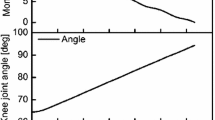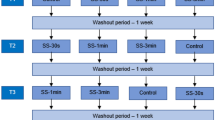Abstract
Acute bouts of static stretching have been shown to impair performance. Most published studies have incorporated static stretching that stressed the muscle(s) to the point of discomfort (POD). There are very few studies that have examined the effects of submaximal intensity (less than POD) static stretching on subsequent performance. Ten participants were pre-tested by performing two repetitions of three different stretches to assess range of motion (ROM) and two repetitions each of five different types of jumps. Following pre-testing, participants were stretched four times for 30 s each with 30 s recovery for the quadriceps, hamstrings and plantar flexors at 100% (POD), 75% and 50% of POD or a control condition. Five minutes following the stretch or control conditions, they were tested post-stretch with the same stretches and jumps as the pre-test. All three stretching intensities adversely affected jump heights. With data collapsed over stretching intensities, there were significant decreases in jump height of 4.6% (P = 0.01), 5.7% (P < 0.0001), 5.4% (P = 0.002), 3.8% (P = 0.009) and 3.6% (P = 0.008) for the drop jump, squat jump, countermovement jump (CMJ) to a knee flexion of 70°, CMJ using a preferred jump strategy and short amplitude CMJ respectively. An acute bout of maximal or submaximal intensity stretching can impair a variety of jumping styles and based on previous research, it is hypothesized that changes in muscle compliance may play a role.


Similar content being viewed by others
References
Alter MJ (1996) Science of flexibility. Human Kinetics, Champaign, pp 237–261
Avela J, Kyröläinen H, Komi PV (1999) Altered reflex sensitivity after repeated and prolonged passive muscle stretching. J Appl Physiol 86:1283–1291
Bandy WD, Irion JM (1994) The effect of time on the static stretch of the hamstrings muscles. Phys Therapy 74(9):845–850
Bandy WD, Irion JM, Briggler M (1997) The effect of time and frequency of static stretching on flexibility of the hamstring muscles. Phys Therapy 77:1090–1096
Behm DG, Button DC, Butt JC (2001) Factors affecting force loss with prolonged stretching. Can J Appl Physiol 26:261–272
Behm DG, Bambury A, Cahill F, Power K (2004) Effect of acute static stretching on force, balance, reaction time, and movement time. Med Sci Sports Exerc 36:1397–1402
Behm DG, Bradbury EE, Haynes AT, Hodder JN, Leonard AM, Paddock NR (2006) Flexibility is not related to stretch-induced deficits in force or power. J Sports Sci Med 5:33–42
Binder-Macleod SA, Lee SCK (1996) Catchlike property of human muscle during isovelocity movements. J Appl Physiol 80:2051–2059
Canadian Society for Exercise Physiology (2003) Professional fitness and lifetyle consultant resource manual. Health Canada, Ottawa, pp 5.1–5.6
Cohen J (1988) Statistical power analysis for the behavioural sciences. L. Erlbaum Associates, Hillside, pp 198–212
Cornwell A, Nelson A, Sidaway B (2002) Acute effects of stretching on the neuromechanical properties of the triceps surae muscle complex. Eur J Appl Physiol 86:428–434
Eyring JE, Murray WR (1964) The effect of joint position on the pressure of intra-articular effusions. J Bone Joint Surg 46A:1235–1241
Fowles JR, Sale DG, MacDougall JD (2000) Reduced strength after passive stretch of the human plantar flexors. J Appl Physiol 89:1179–1188
Guissard N, Duchateau J, Hainaut K (2001) Mechanisms of decreased motoneurone excitation during passive muscle stretching. Exp Brain Res 137:163–169
Hubley-Kozey CL (1991) Testing flexibility. In: MacDougall JD, Weger HA, Green HJ (eds) Physiological testing of the high performance athlete. Human Kinetics, Champaign, pp 309–359
Jayson MI, Dixon A (1970) Intra-articular pressure in rheumatoid arthritis of the knee. I. Pressure changes during passive joint distension. Ann Rheumatic Dis 29:261–265
Kawakami Y, Kubo K, Kanehisa H, Fukunaga T (2002) Effect of series elasticity on isokinetic torque-angle relationship in humans. Eur J Appl Physiol 87:381–387
Kibele A (1998): Possibilities and limitations in the diagnosis of countermovement jumps—a methodological study. J Appl Biomech 14:105–117
Kibele A (1999) Possible errors in the comparative evaluation of drop jumps from different heights—a methodological study. Ergonomics 42:1011–1014
Knudson D, Bennett K, Corn R, Leick D, Smith C (2001) Acute effects of stretching are not evident in the kinematics of the vertical jump. J Strength Cond Res 15:98–101
Knudson DV, Noffal GJ, Bahamonde RE, Bauer JA, Blackwell JR (2004) Stretching has no effect on tennis serve performance. J Strength Cond Res 18:654–656
Kokkonen J, Nelson AG, Cornwell A (1998) Acute muscle stretching inhibits maximal strength performance. Res Quart Exerc Sport 69:411–415
Kubo K, Morimoto M, Kumoru T, Tsunoda N, Kanehisa H, Fukunaga T (2007) Influences of tendon stiffness, joint stiffness, and electromyographic activity on jump performances using single joint. Eur J Appl Physiol 99:235–243
Magnusson SP, Simonsen EB, Aagaard P, Sorensen H, Kjaer M (1996a) A mechanism for altered flexibility in human skeletal muscle. J Physiol 497(1):291–298
Magnusson SP, Simonsen EB, Dyhre-Poulsen P, Aagaard P, Mohr T, Kjaer M (1996b) Viscoelastic stress relaxation during static stretch in human skeletal muscle in the absence of EMG activity. Scand J Med Sci Sports 6:323–328
Magnusson SP, Aagaard P, Nielsen JJ (2000) Passive energy return after repeated stretches of the hamstring muscle tendon unit. Med Sci Sport Exerc 32:1160–1164
McGraw KO, Wong SP (1996) Forming inferences about some intraclass correlation coefficients. Psychol Methods 1:30–46
Power K, Behm D, Cahill F, Carroll M, Young W (2004) An acute bout of static stretching: effects on force and jumping performance. Med Sci Sports Exerc 36:1389–1396
Rassier DE, MacIntosh BR, Herzog W (1999) Length dependence of active force production in skeletal muscle. J Appl Physiol 86:1445–1457
Reisman S, Walsh LD, Proske U (2005) Warm-up stretches reduce sensations of stiffness and soreness after eccentric exercise. Med Sci Sports Exerc 37(6):929–936
Rosenbaum D, Hennig E (1995) The influence of stretching and warm-up exercises on achilles tendon reflex activity. J Sport Sci 13:481–490
Toft E, Espersen GT, Kålund S, Sinkjær T, Hornemann BC (1989) Passive tension of the ankle before and after stretching. Am J Sports Med 17:489–494
Vincent WJ (1999) Statistics in kinesiology. Human Kinetics, Champaign, pp 182–185
Wilson G, Wood G, Elliott B (1991) The relationship between stiffness of the musculature and static flexibility: an alternative explanation for the occurrence of muscular injury. Int J Sport Med 12:403–407
Wilson G, Elliot B, Wood G (1992) Stretching shorten cycle performance enhancement through flexibility training. Med Sci Sport Exerc 24:116–123
Young WB, Behm DG (2003) Effects of running, static stretching and practice jumps on explosive force production and jumping performance. J Sports Med Phys Fitness 43:21–27
Young W, Elliott S (2001) Acute effects on static stretching, proprioceptive neuromuscular facilitation stretching, and maximum voluntary contractions on explosive force production and jumping performance. Res Quart Exerc Sport 72:273–279
Young W, Elias G, Power J (2006) Effects of static stretching volume and intensity on plantar flexor explosive force production and range of motion. J Sports Med Phys Fitness 46(3):403–411
Acknowledgments
This research was supported by a grant from the National Science and Engineering Research Council (NSERC) of Canada and by a grant from the University of Kassel.
Author information
Authors and Affiliations
Corresponding author
Rights and permissions
About this article
Cite this article
Behm, D.G., Kibele, A. Effects of differing intensities of static stretching on jump performance. Eur J Appl Physiol 101, 587–594 (2007). https://doi.org/10.1007/s00421-007-0533-5
Accepted:
Published:
Issue Date:
DOI: https://doi.org/10.1007/s00421-007-0533-5




